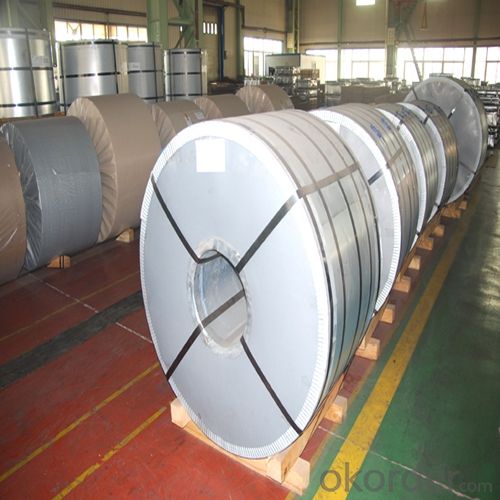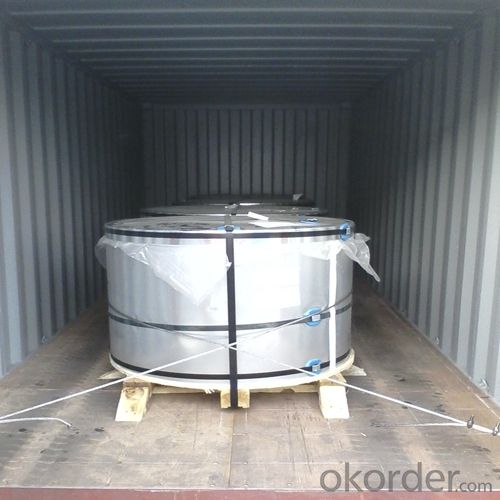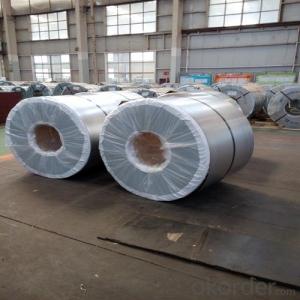Tin Free Steel of Prime Quality for Metal Caps or Crowns
- Loading Port:
- Tianjin
- Payment Terms:
- TT OR LC
- Min Order Qty:
- 25 m.t.
- Supply Capability:
- 15000 m.t./month
OKorder Service Pledge
OKorder Financial Service
You Might Also Like
Item specifice
1.Structure of Tin Free Steel of Prime Quality for Metal Caps or Crowns Description
Also known as chromed steel, tin-free steel (TFS) is obtained by coating the metal base (low-carbon steel) with an ultra-thin layer of metallic chrome and then with a chromium oxide layer.
2.Main Features of the Tin Free Steel of Prime Quality for Metal Caps or Crowns
Chromium coated
Corrosion Resistant
Sulphur Blackening Resistance: TFS has sulphur resistance properties, which can be used for canning protein- rich food such as fish.
Filiform Rust Resistance: Filiform is superficial corrosion of the base metal. TFS has a superior base metal which makes it corrosion resistance.
Paint Adhesion : TFS possesses better paint adhesion properties, thus making it ideal for DRD cans and adhesive bonded cans.
Weldability: TFS can be welded when metallic coating layers are removed by edge grinding.
TFS should be Lacquered / Coated to prevent rust in humid condition.
Internal Coating / Lacquering can be avoided in the case of TFS used to store motor oil or cooking oil.
3.Tin Free Steel of Prime Quality for Metal Caps or Crowns Images


4.Tin Free Steel of Prime Quality for Metal Caps or Crowns Specification
Specification of :
Material: MR,SPCC
Thickness:0.15mm - 0.50mm
Width: 600mm -1150mm
Temper: T1-T5
Annealing: BA & CA
Coil Inner Diameter: 508mm
Weight: 6-10 tons/coil 1~1.7 tons/sheets bundle
Oil: DOS
Surface: Finish,bright,stone,matte,silver
5.FAQ of Tin Free Steel of Prime Quality for Metal Caps or Crowns
-What is MOQ?
Our MOQ would be 25 tons.
- Do you only have prime quality TFS ?
We can supply both prime and second quality TFS.
- Q:Tinplate why have white and yellow, tin plating should be white ah, yellow is how to return a responsibility?
- Tinplate itself is no color, it is iron color.
- Q:What are the advantages of using tinplate for construction materials?
- One of the main advantages of using tinplate for construction materials is its exceptional durability and corrosion resistance. Tinplate is a steel sheet coated with a thin layer of tin, which provides a protective barrier against rust and other forms of corrosion. This makes it ideal for construction applications where exposure to moisture or extreme weather conditions is a concern. Additionally, tinplate is lightweight and easy to work with, allowing for efficient installation and reducing the overall weight of the structure. Its aesthetic appeal, versatility, and recyclability are also notable advantages that make tinplate a preferred choice for various construction needs.
- Q:How is tinplate coated?
- Tinplate is coated through a process called electrolytic tinning. In this process, a thin layer of tin is electroplated onto the surface of steel sheets or strips. The steel is immersed in an electrolyte bath containing tin salts, and an electric current is passed through the bath. This causes the tin to deposit onto the steel surface, creating a protective coating that prevents corrosion and enhances the appearance of the tinplate.
- Q:What are the main properties of tinplate?
- Tinplate is a type of steel coated with a thin layer of tin, which gives it several unique properties. Firstly, tinplate is highly corrosion-resistant, making it ideal for packaging food and beverages. It also has excellent solderability, allowing for easy and secure sealing of cans. Additionally, tinplate has good formability, meaning it can be easily shaped into different containers or components. Lastly, tinplate has a bright and attractive appearance, making it popular for decorative purposes as well.
- Q:Who can tell me how to adjust the roller seal defects?
- In the sealing device, the roll sealing roller, the upper pressure head tray, usually referred to as sealing three elements. The correct groove shape of the roller, the reasonable position of the head and the proper driving force of the tray support are the necessary conditions to ensure the normal roll sealing. (see Fig. 1) it is easy to see that the three elements of the seal are the basic components of the sealing device and are also a fundamental factor affecting the double hemming.
- Q:How does tinplate contribute to the overall stackability of packaging?
- Tinplate, being a lightweight and durable material, greatly contributes to the overall stackability of packaging. Its rigid structure ensures that the packaging can be safely stacked without collapsing or damaging the contents. This allows for efficient use of storage space and easy transportation, making tinplate an ideal choice for stackable packaging solutions.
- Q:How does tinplate packaging contribute to product freshness?
- Tinplate packaging contributes to product freshness by providing a hermetically sealed and protective barrier against external elements such as moisture, air, and light. This helps to preserve the quality, flavor, and aroma of the product over a longer period of time, ensuring that it reaches consumers in its original state. Additionally, tinplate packaging is resistant to corrosion, preventing any potential contamination that could compromise the freshness of the product.
- Q:Can tinplate be used for high-temperature applications?
- No, tinplate is not suitable for high-temperature applications due to its low melting point.
- Q:What are the common uses of tinplate?
- Tinplate is commonly used in the packaging industry for making cans, containers, and lids for food and beverages. It is also used in the production of aerosol cans, paint cans, and metal closures. Additionally, tinplate is used for making various household items such as kitchen utensils, storage boxes, and tin toys.
- Q:What are the disadvantages of using tinplate?
- One disadvantage of using tinplate is its relatively high cost compared to other materials. Additionally, tinplate can be prone to corrosion if not properly coated or maintained. It is also less flexible than some alternative materials, making it less suitable for certain applications. Lastly, tinplate can be challenging to recycle due to the complexity of separating the tin coating from the steel, which can contribute to environmental concerns.
1. Manufacturer Overview |
|
|---|---|
| Location | |
| Year Established | |
| Annual Output Value | |
| Main Markets | |
| Company Certifications | |
2. Manufacturer Certificates |
|
|---|---|
| a) Certification Name | |
| Range | |
| Reference | |
| Validity Period | |
3. Manufacturer Capability |
|
|---|---|
| a)Trade Capacity | |
| Nearest Port | |
| Export Percentage | |
| No.of Employees in Trade Department | |
| Language Spoken: | |
| b)Factory Information | |
| Factory Size: | |
| No. of Production Lines | |
| Contract Manufacturing | |
| Product Price Range | |
Send your message to us
Tin Free Steel of Prime Quality for Metal Caps or Crowns
- Loading Port:
- Tianjin
- Payment Terms:
- TT OR LC
- Min Order Qty:
- 25 m.t.
- Supply Capability:
- 15000 m.t./month
OKorder Service Pledge
OKorder Financial Service
Similar products
New products
Hot products
Related keywords



























